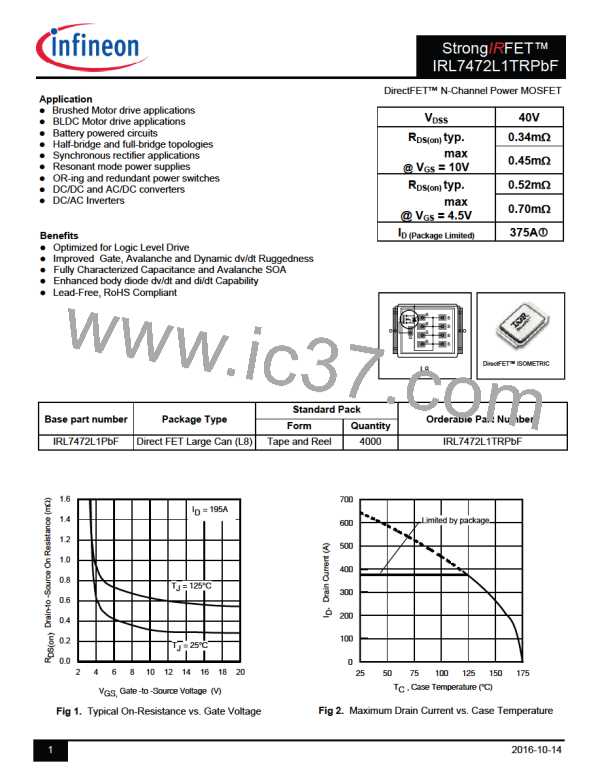IRL7472L1TRPbF
1
0.1
D = 0.50
0.20
0.10
0.05
0.02
0.01
0.01
SINGLE PULSE
( THERMAL RESPONSE )
0.001
Notes:
1. Duty Factor D = t1/t2
2. Peak Tj = P dm x Zthjc + Tc
0.0001
1E-006
1E-005
0.0001
0.001
0.01
0.1
t
, Rectangular Pulse Duration (sec)
1
Fig 14. Maximum Effective Transient Thermal Impedance, Junction-to-Case
1000
100
10
Allowed avalanche Current vs avalanche
pulsewidth, tav, assuming Tj = 125°C and
Tstart =25°C (Single Pulse)
Allowed avalanche Current vs avalanche
pulsewidth, tav, assuming j = 25°C and
Tstart = 125°C.
1
1.0E-06
1.0E-05
1.0E-04
1.0E-03
1.0E-02
1.0E-01
tav (sec)
Fig 15. Avalanche Current vs. Pulse Width
350
300
250
200
150
100
50
TOP
Single Pulse
Notes on Repetitive Avalanche Curves , Figures 15, 16:
(For further info, see AN-1005 )
1.Avalanche failures assumption:
BOTTOM 1.0% Duty Cycle
= 195A
I
D
Purely a thermal phenomenon and failure occurs at a
temperature far in excess of Tjmax. This is validated for every
part type.
2. Safe operation in Avalanche is allowed as long asTjmax is not
exceeded.
3. Equation below based on circuit and waveforms shown in Figures
23a, 23b.
4. PD (ave) = Average power dissipation per single avalanche pulse.
5. BV = Rated breakdown voltage (1.3 factor accounts for voltage
increase during avalanche).
6. Iav = Allowable avalanche current.
7. T = Allowable rise in junction temperature, not to exceed Tjmax
(assumed as 25°C in Figure 14, 15).
0
tav = Average time in avalanche.
D = Duty cycle in avalanche = tav ·f
25
50
75
100
125
150
175
ZthJC(D, tav) = Transient thermal resistance, see Figures 13)
Starting T , Junction Temperature (°C)
J
PD (ave) = 1/2 ( 1.3·BV·Iav) = T/ ZthJC
I
av = 2T/ [1.3·BV·Zth]
Fig 16. Maximum Avalanche Energy vs. Temperature
EAS (AR) = PD (ave)· av
t
6
2016-10-14

 INFINEON [ Infineon ]
INFINEON [ Infineon ]